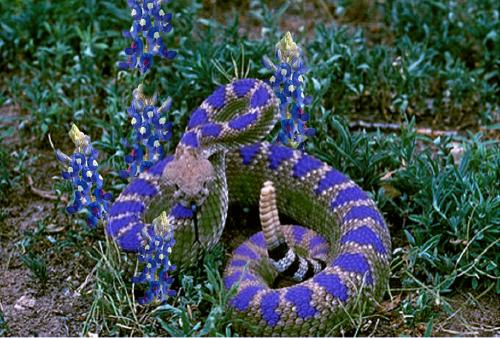Claim: Photograph shows a newly-discovered snake species known as the Texas Bonnet Rattlesnake.
Example: [Collected via Facebook, April 2014]
Texas Hill Country face book page has posted a photo of a supposedly evolved rattlesnake that appears to have adopted blue markings making it possible to blend in with the beautiful road side blue bonnet fields. Since its very common practice for people to catch photo ops wherever these fields of flowers appear, this is big news if it's true.

Origins: 1 April 2014 saw the online publishing of an article about the putative discovery of new species of snake known as the Texas Bonnet Rattlesnake, a serpent that had supposedly evolved to sport a blue coloration which allowed it to blend in unnoticed amidst fields of the ubiquitous Texas state flower, the bluebonnet:
several images and a description of the animal: Crotalus Lupinus (Texas Bonnet Rattlesnake). Dr. William Nye, founder of TITA and Professor of Biological Sciences at The University of Texas, released this statement after visiting Bend, Texas to inspect the snake over the weekend: "This weekend, we had the opportunity to observe a previously unknown specimen in Bend, Texas. The Governing Committee at TITA has designated the snake's scientific name as 'Crotalus Lupinus,' and the discoverer, Robert McCrae, has assigned the common name of 'Texas Bonnet Rattlesnake.' While a lot of research is still needed, this find reestablishes everything we teach about natural selection and adaptation. The snake has obvious similarities to the Lupinis Texensis, or Bluebonnet. It is safe to say, with certainty, that this rattlesnake has reached an evolutionary point where it is interacting with our Texas State Flower. This is the first Texas Bonnet Rattlesnake that we have documented but maybe that's the whole point ... this species has evolved so they will NOT be seen. Evolution is Nature’s smartest tool and I remain hopeful that future data reveals a thriving new species."
On Saturday morning, the Texas Identification and Taxonomy Association tweeted that several members were en route to Bend, Texas after local game wardens were unable to identify an "unusual organism." On Monday morning, TITA confirmed that the animal was "a previously unknown species of snake" and released
The aftermath of every April 1 sees a few online jokes that linger and continue to fool and confuse readers well after that day has come and passed, and this item is proving to be one of them. As indicated by the
One can certainly find plenty of rattlesnakes and bluebonnets in Texas, sometimes in the same place, but for now neither species has started resembling the other.
Last updated: 2 April 2014
